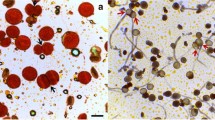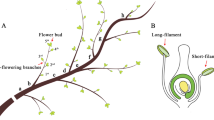Abstract
To understand the correlation between chromosomes behavior and fertility in autotriploid cucumber (Cucumis sativus L.), microsporogenesis in pollen mother cells (PMCs) and male gametophyte development were studied using improved staining and chromosome preparation techniques. Meanwhile, for more efficient selection of trisomics from the progeny of autotriploid-diploid crosses, fertilization rates of ovules from reciprocal crosses were counted to observe the transfer rate of gametes in the autotriploid cucumber. Variable chromosome configurations, e.g. multivalents, quadrivalents, trivalents, bivalents and univalents were observed in the most PMCs of the autotriploids at metaphase I. Chromosome lagging and bridges at anaphase in both meiotic divisions resulted from irregular chromosome separation and asynchronization was frequently observed as well, which led to formation of micronuclei and inviable gametes. The frequency of normal PMCs in autotriploids at the stage of tetrad was only 40.6%. Among those normal microspores, most of them (91.2%) could develop into normal gametophytes with 2 cells and 3 germ pores. Stainability and germination rate of pollen grains were only 18.8 and 13.5%, respectively. However, chromosomes separated to form gametes with 8 chromosomes at anaphase I, suggesting a possible method for the production of primary trisomics from the progeny of autotriploid-diploid crosses. Fruit set of 3n × 2n and 2n × 3n were 80 and 70%, respectively. It obtained an average of 6.2 plump seeds per fruit in 3n × 2n, while 4.9 in 2n × 3n crosses. Transfer rates of gametes through the gastrula or the pollen in autotriploids were 13.4 and 10.4%, respectively. Some aneuploid gametes (n + 1 = 8, n + 2 = 9) also have capability of setting seed and sexual reproduction besides normal gametes containing whole chromosome sets (n = 7, 2n = 14). Further, some primary trisomic plants were selected from the progeny of autotriploid-diploid crosses. Based on the results obtained we suggest that abnormal meiosis in PMCs was the cytogenetic reason for low fertility of autotriploid cucumber pollen. 3n × 2n cross was more efficient for selecting primary trisomic plants in cucumber.

Similar content being viewed by others
References
Cao QH, Chen JF, Qian CT, Guo JY (2004) Cytological studies on meiosis and male gametophyte development in cucumber. Acta Bot Boreal Occident Sin 24(9):1721–1726
Chen JF, Staub JE, Qian CT (2003) Reproduction and cytogenetic characterization of interspecific hybrids derived from Cucumis hystrix Chakr. × Cucumis sativus L. Theor Appl Genet 106:688–695
Chen JF, Ch Lei, Qian CT, Zhuang FY (2004) Synthesis and characterization of autotetraploid in cucumber polyploid breeding. Pl Physiol Commun 40(2):149–153
Costa JY, Forni-Martins ER (2004) A triploid cytotype of Echinodorus tennellus. Aquat Bot 79:325–332
Dane F (1991) Cytogenetics in genus Cucumis. In: Tsuchiya T, Gupta PK (eds) Chromosome engineering in plants, Part B. Genet, Breeding, and Evol. Elsevier, Amsterdam, pp 201–204
Dane F, Tsuchiya T (1976) Chromosome studies in the genus Cucumis. Euphytica 25:367–374
Gao SL, Zhu DN, Cai ZH, Xu DR (1996) Autotetraploid plants from colchicine treated bud culture of Salvia miltiorrhiza Bge. Pl Cell Tissue Organ Culture 47:73–77
Gaonkar RV, Torne SG (1991) Induced autotetraploidy in Ageratum conyzoides L. Cytologia 56(3):327–331
Guo JY, Chen JF, Cao QH, Luo XD (2004) Cytological studies on microsporogenesis and male gametophyte development in a Cucumis allotriploid derived from Cucumis hytivus x C. sativus. Cytologia 69(3):335–340
Khazanehdari KA, Jones GH (1997) The causes and consequences of meiotic irregularity in the leek (Allium ampeloprasum spp. porrum); implication for fertility, quality and uniformity. Euphytica 93:313–319
Khush GS, Singh RJ (1984) Primary trisomic of rice: origin, morphology, cytology, and use in linkage mapping. Genetica 107:141–163
Koshun I (1991) Cytogenetical studies on African rice, Oryza glaberrima Steud. 3. Primary trisomics produced by pollinating autotriploid with diploid. Euphytica 55:7–13
Kouzou O, Kagayaki M, Esturo Y, Katsutoshi A (2005) Reproductive capacity of triploid loaches obtained from Hokkaido Island, Japan. Ichthyological Res 52:1–8
Lange W, Wagenvoort M (1973) Meiosis in triploid Solanum tuberosum L. Euphytica 22:8–18
Li SX, Wu ZJ, Yang ZG, Li MZ (2002) The breeding of autotetraploid eggplant cultivar Xinqie No 1. Scientia Agricultura Sinica 35(6):686–689
Luan L, Tu SB, Long WB, Wang X, Liu YH, Kong FL, He T, Yan WG, Yu MQ (2007) Cytogenetic studies on two F1 hybrids of autotetraploid rice varieties showing extremely high level of heterosis. Pl Syst Evol 267:205–213
Mackiewicz HO, Malepszy S (1996) Obtaining and characterization of tetraploid froms in cucumber Cucumis sativus L. var. sativus and var. hardwickii Alef. Folia-Hort 8(1):3–10
Man H, Zhang CH, Liu LB, Shen SX, Sun ZW (2005) The triploid obtained from tetraploid by diploid crosses and its cytological studies in cabbage. J Pl Genetic Resources 6(4):405–408
Muhammad JJ, Sung WK, Dae HK (2005) Comparative study on vegetative, reproductive and qualitative traits of seven diploid and tetraploid watermelon lines. Euphytica 145:259–268
Qian CT, Chen JF, Lou QF, Cao QH, Luo XD (2003) Studies on meiotic behaviors of pollen mother cells in cucumbers (Cucumis sativus L.). J Wuhan Bot Res 21(3):193–197
Romagosa I, Hecker RJ, Tsuchiya T, Lasa JM (1986) Primary trisomics in sugarbeet. I. Isolation and morphological characterization. Crop Sci 26:243–248
Simeonova E, Wypiorkiewicz E, Charzynaka M (1999) Pollen development in Cucumis sativus L. Acta Biologica Cracoviensia Series Botanica 41:139–142
Wang ZM, Niu Y, Song M, LI Y (2002) Advances on applications of ploidy induction in vegetable. J Biol 12(6):35–38
Webster AD (1996) Cherry rootstock evaluation at East Malling. Acta Hort 410:247–255
Xu SJ, Singh RJ, Kollipara KP, Hymowitz T (2000) Primary trisomics in soybean: origin, identification, breeding behavior, and use in linkage mapping. Crop Sci 40:1543–1551
Yanava KS, Singh AK, Arya HC (1984) Cytogenetic investigation in Cucumis L. I. Meiotic analysis in twenty-four Cucumis species. Cytologia 49:1–9
Zhang J, Wu XJ, Wang XD, Zhou KD, Peng H (2002) Cytological study on a special autotriploid rice SAR-3. Acta Agronomica Sinica 9:704–708
Zhang SN, Wan SF, Zhang W, Hou XL (2007) Meiosis of pollen mother cells in autotetraploid broccoli. Acta Horticulturae Sinica 34(2):387–390
Acknowledgments
The authors wish to thank Mr. Ahmed Abbas Malik for his valuable suggestions. This research was supported by the Key Program (30830079), the General Program 30700541 and 30671419 from the National Natural Science Foundation of China; the ‘863’ Programs (2006AA10Z1A8, 2006AA100108, 2008AA10Z150) and the ‘111’ Project (B08025), the ‘973’ Program, the State Supporting Programs (2006BAD13B06, 2006BAD01A7-5-11) from the Ministry of Science and Technology of China.
Author information
Authors and Affiliations
Corresponding author
Rights and permissions
About this article
Cite this article
Diao, WP., Bao, SY., Jiang, B. et al. Cytogenetic studies on microsporogenesis and male gametophyte development in autotriploid cucumber (Cucumis sativus L.): implication for fertility and production of trisomics. Plant Syst Evol 279, 87–92 (2009). https://doi.org/10.1007/s00606-009-0148-x
Received:
Accepted:
Published:
Issue Date:
DOI: https://doi.org/10.1007/s00606-009-0148-x




